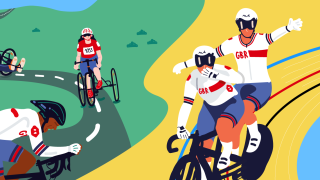Para-Cycling classification system determines which athletes are eligible to compete and how they are grouped for competition. In cycling, athletes are grouped by the degree of activity limitation resulting from the impairment.
The purpose of classification is to minimise the impact of the eligible impairment on the outcome of competition. So, the athlete with the best skills, physical fitness, athletic talent and training is successful.
Eligible Impairment Types
In Para-cycling there are eight eligible impairment types. An athlete must have at least one of the eligible impairment types listed below and that must be permanent and be the direct result of an underlying health condition (for example; trauma, disease, dysgenesis).
Eligible Impairment Type |
Examples of an Underlying Health Condition that can lead to the Eligible Impairment |
|
Impaired Muscle Power A Health Condition that either reduces or eliminates their ability to voluntarily contract their muscles in order to move or to generate force. |
Includes spinal cord injury (complete or incomplete, tetra-or paraplegia or paraparesis), muscular dystrophy, post-polio syndrome and spina bifida. |
|
Impaired Passive Range of Movement A restriction or a lack of passive movement in one or more joints. |
Includes arthrogryposis and contracture resulting from chronic joint immobilisation or trauma affecting a joint. |
|
Limb Deficiency Total or partial absence of bones or joints as a consequence of trauma, illness or congenital limb deficiency. |
Includes traumatic amputation, amputation as a result of illness or dysmelia. |
|
Leg Length Difference A difference in the length of the athlete’s legs. |
Includes disturbance of limb growth or as result of trauma. |
|
Hypertonia An increase in muscle tension and a reduced ability of a muscle to stretch caused by damage to the central nervous system. |
Includes cerebral palsy, traumatic brain injury and stroke. |
|
Ataxia Uncoordinated movements caused by damage to the central nervous system. |
Includes cerebral palsy, traumatic brain injury, stroke and multiple sclerosis. |
|
Athetosis Continual slow involuntary movements. |
Includes cerebral palsy, traumatic brain injury and stroke. |
|
Vision Impairment Reduced or no vision caused by damage to the eye structure, optical nerves or optical pathways, or visual cortex of the brain. |
Includes retinitis pigmentosa and diabetic retinopathy. |
Minimum Impairment Criteria
In addition to the eight eligible impairment types the UCI set a minimum impairment criteria to ensure that an Athlete’s eligible impairment affects the extent to which an athlete is able to execute the specific tasks and activities fundamental to Para-cycling.
Eligible Impairment Type |
UCI minimum impairment criteria |
|
Impaired Muscle Power |
Upper Limb – Full loss of grip in one hand, inability to form and maintain a cylindrical grasp – Muscle Grade 0 Lower Limb – Inability to heel raise to 25 degrees tested in single leg stance. Comparable incomplete spinal cord injury or comparable multiple impairment with a tested point score between 20 and 59 points. |
|
Impaired Passive Range of Movement |
Loss of passive range of movement comparable with a tested point score of between 20 and 59 points |
|
Limb Deficiency
|
Upper Limb – Amputation of all fingers and thumb through MCP (or dysmelia with no functional grip – muscle grade 0) Lower Limb – Amputations of the foot through Lisfranc or comparable dysmelia |
|
Leg Length Difference |
The difference in length between the right and left legs must be equal to or more than 7cm. |
|
Hypertonia
|
Spasticity grade 1 in the affected arm or leg plus clear neurological signs to demonstrate upper and motor neuron lesion Positive unilateral or bilateral Hoffman/Babinski; Noticeably brisk reflexes or clear differences in reflexes left vs. right. |
|
Ataxia |
Occasional and mild or subtle signs of Ataxia (reference to SARA scale) |
|
Athetosis
|
Occasional Dyskinesia signs with mild or subtle intensity or amplitude of movement (reference to DIS scale). Unilateral or bilateral (symmetrical/asymmetrical) |
|
Vision Impairment
|
Minimum Impairment Criteria for athletes with a vision impairment have been set based on the athlete’s corrected vision. The difference in approach for athletes with a vision impairment must be seen within the historical context of Classification for these athletes, which is an assessment with ‘best correction’ as used in the context of medical diagnostics for visual acuity. The athlete must meet both of the criteria below: The athlete must have at least one of the following impairments:
The athlete’s visual impairment must result in a visual acuity of less than or equal to LogMAR 1.0 or a visual field restricted to less than 40 degrees diameter. |
Para-Cycling Classifications - Overview
The UCI classification system groups athletes together into different divisions and sport classes.
There are 4 sport classes, Bicycles (B-division), Tricycles (T-division), Handcycles (H-division) and Tandems (B-division).
Each division is sub-divided into different sport classes depending on the type and severity of an individuals impairment, riders through the classification process are allocated an appropriate sport class in light of their functional ability.
There are 13 sport classes in total for both men and women, B, C1-5, H1-5 and T1-2.
The road cycling see athletes compete on bicycles, tricycles, handcycles or tandems, whereas the track cycling is either bicycles or tandems.
A guide to the UCI Para-Cycling Classes
How Do I Get Classified?
Formal national classification assessments are completed in person with a trained classification panel at one of the four classification assessment dates throughout the year.
We encourage individuals to undertake a classification assessment before they enter any Para-Cycling race, however, in some cases a provisional class can be given to an athlete, allowing them to compete on the provision that they attend the next available classification date.
To receive a classification assessment appointment athletes must meet the following criteria:
- At least one of the eligible impairment types listed in the eligible impairment type table (above) and that must be permanent and be the direct result of an underlying health condition.
- Hold a British passport.
- A Medical Diagnostics Form [Physical Impairment (PI)]
- A Medical Diagnostics Form [Visual Impairment (VI)]
Please download the relevant form and follow instructions at the top of the form which must be completed by a registered Medical Doctor or Ophthalmologist. Completed forms and supporting documentation should be e-mailed to classification@britishcycling.org.uk
Upon receipt of completed documentation we will be in contact following a review by a member of the national classification team of all the information provided. Classification appointments will then be assigned in accordance with available dates and appointment slots.
For enquiries or more information, please e-mail classification@britishcycling.org.uk








